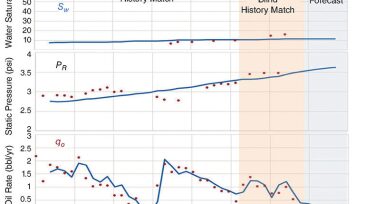history matching
-
One unfortunate consequence of a base-case model, however, is the risk of an anchoring effect, in which case we may underestimate uncertainty. Essentially, the anchoring effect refers to our tendency to rely too heavily on the information offered, introducing a bias in the model-construction process
-
This paper presents a novel approach to generate approximate conditional realizations using the distributed Gauss-Newton (DGN) method together with a multiple local Gaussian approximation technique.
-
This paper presents a comparison of existing work flows and introduces a practically driven approach, referred to as “drill and learn,” using elements and concepts from existing work flows to quantify the value of learning (VOL).
-
This work presents a systematic and rigorous approach of reservoir decomposition combined with the ensemble Kalman smoother to overcome the complexity and computational burden associated with history matching field-scale reservoirs in the Middle East.
-
Young Technology Showcase—Top-Down Modeling: A Shift in Building Full-Field Models for Mature FieldsData-driven, or top-down, modeling uses machine learning and data mining to develop reservoir models based on measurements, rather than solutions of governing equations.
-
In this paper, the authors introduce a novel semianalytic approach to compute the sensitivity of the bottomhole pressure (BHP) data with respect to gridblock properties.
-
This paper critically investigates the impact of using realistic, inaccurate simulation models. In particular, it demonstrates the risk of underestimating uncertainty when conditioning real-life models to large numbers of field data.
-
History matching is only one part of something more comprehensive—reservoir modeling.
-
In this paper, the authors derive and implement an interwell numerical simulation model (INSIM) that can be used as a calculation tool to approximate the performance of a reservoir under waterflooding.
-
This paper proposes a framework based on proxies and rejection sampling (filtering) to perform multiple history-matching runs with a manageable number of reservoir simulations.







